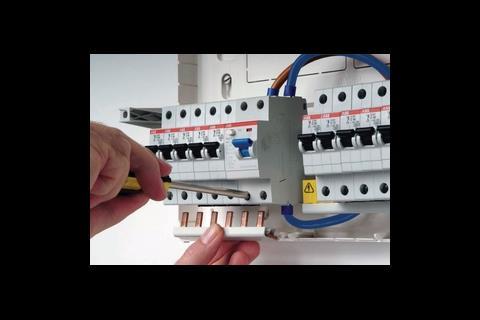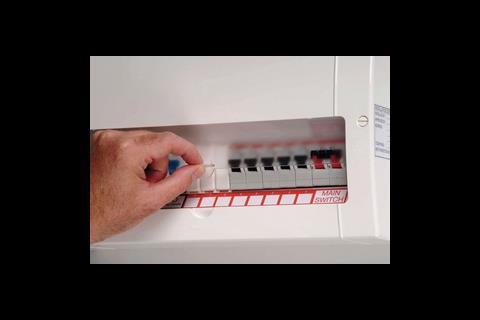Improving electrical safety in the home has been a prominent theme of late, due in part to IEE Wiring Regulations revisions. Alan Roadway discusses the role of electrical installers
Most drivers accept the idea of vehicle MOTs as an important safety measure yet few house-holders have their electrical installations professionally checked on a regular basis.
More than 40% of Britons have never had their home electrics checked and 24% do not know how old their wiring is, according to the Electrical Safety Council. Nearly 30% of homeowners said they would not pay for an inspection by a registered electrician.
The National Inspection Council for Electrical Installation Contracting (NICEIC) says domestic installations should be checked at least every 10 years, but the message is not reaching everyone. On average, there are 10 deaths and more than 750 injuries annually because of faulty electrics, the NICEIC says. Electrical faults cause 12,500 fires, resulting in about 25 deaths and 600 injuries.
Regulating safety
The situation should improve as a result of the revisions to the IEE Wiring Regulations, which were introduced in January. The government’s regulatory impact assessment estimated that 30% of electrical accidents were a result of poor workmanship.
The Wiring Regulations now stipulate that any significant electrical work should be carried out by a “competent” person. Simple jobs, such as replacing a plug or changing a light fitting, can still be tackled by DIY enthusiasts. But other, more complex jobs, such as adding a circuit, and any electrical work in a “special” location such as a bathroom must be approved so as not to pose a safety risk.
The regulatory changes, however, do not compel householders to have electrical systems checked or to upgrade older installations. In addition, there are more demands being placed on domestic electrical systems than ever before as people rely increasingly on new electrical goods, ranging from garden gadgets to IT systems. Any extra burden only increases the risk of problems. Encouraging consumers
Responsible installers therefore have a key role to play in promoting the role of inspection to potential clients. A tick-box checklist can be useful for making people aware of when it’s time to call in the professionals:
- Is the wiring more than 15 years old? Standards have changed. If the age of the system is unknown, there are telltale danger signs, such as round-pin plugs and sockets or lights that use the twisted type of flex.
- Has it been longer than 10 years since the wiring was checked? All systems deteriorate over time.
- Has electrical work been done by amateurs and never checked? Although this may have been legal at the time, it would not comply with today’s regulations.
- Do plugs or sockets get hot? Overheating is usually a sign that too much current is being drawn.
- Do fuses blow regularly and for no obvious reason? This indicates potentially risky current surges.
- Does the householder use adaptors routinely to run multiple appliances from a single outlet? Older systems often provide insufficient sockets to cope with modern lifestyles. Adapters can overload the system and extension cables can put extra strain on the system.
- Are electrical items used outdoors? Running electrical equipment into the open-air demands an electrical system engineered to the highest safety standards. Any electrical socket with equipment used outdoors needs to have a separate residual current device (RCD).
Inspection standards
Regardless of which body electricians are certified with, they will be measuring systems against the yardstick of the IEE Wiring Regulations. The latest standard is BS7671: 17th Edition, which comes into force from 1 June.
The most notable revision is to Section 701. It allows sockets other than SELV or shaver outlets to be installed in the same space as a bath or shower, provided they are more than 3m horizontally from the boundary of zone 1, defined in BS7671 as a space extending for 1.2m around the water outlet.
Proposed works
It is impossible to know what an inspection will reveal, but several points should always be considered. Any old fusebox should be replaced with one of the latest generation adapted for protection requirements of the household by offering a flexible split load.
A main isolating switch will feed essential circuits such as lighting and other circuits and is protected with residual current devices (RCDs). Other devices, such as showers, can be assigned a separate residual current breaker with overload (RCBO) to protect against electrical faults without disrupting the power around the rest of the building. Instead of being confined to typical split load combinations of 4+4 way or 6+6 way only for the different types of protection, some units provide extra flexibility by enabling installers to achieve variations such as 3+5 or 2+6 way.
Miniature circuit breakers (MCBs) are not only reusable and virtually maintenance free but also safer than conventional fuses. They break the connection faster than a conventional fuse and can be more closely tailored to the required capacity. Some equipment, such as computers, has specific electrical needs like surge protection while garden sockets require their own RCD protection.
Spreading the message
The biggest challenge for installers is not technical in nature: it is convincing consumers that regular safety inspections and professional workmanship can save lives.
Source
Building Sustainable Design
Postscript
Alan Roadway is ABB’s product manager for low-voltage distribution products
Original print headline: "shock therapy" (Building Services Journal, May 2008)
























1 Readers' comment